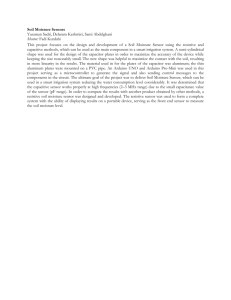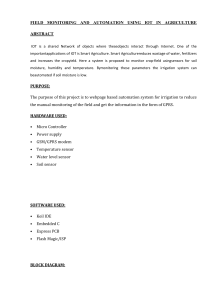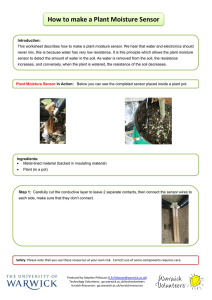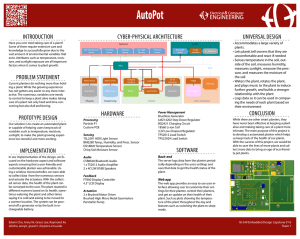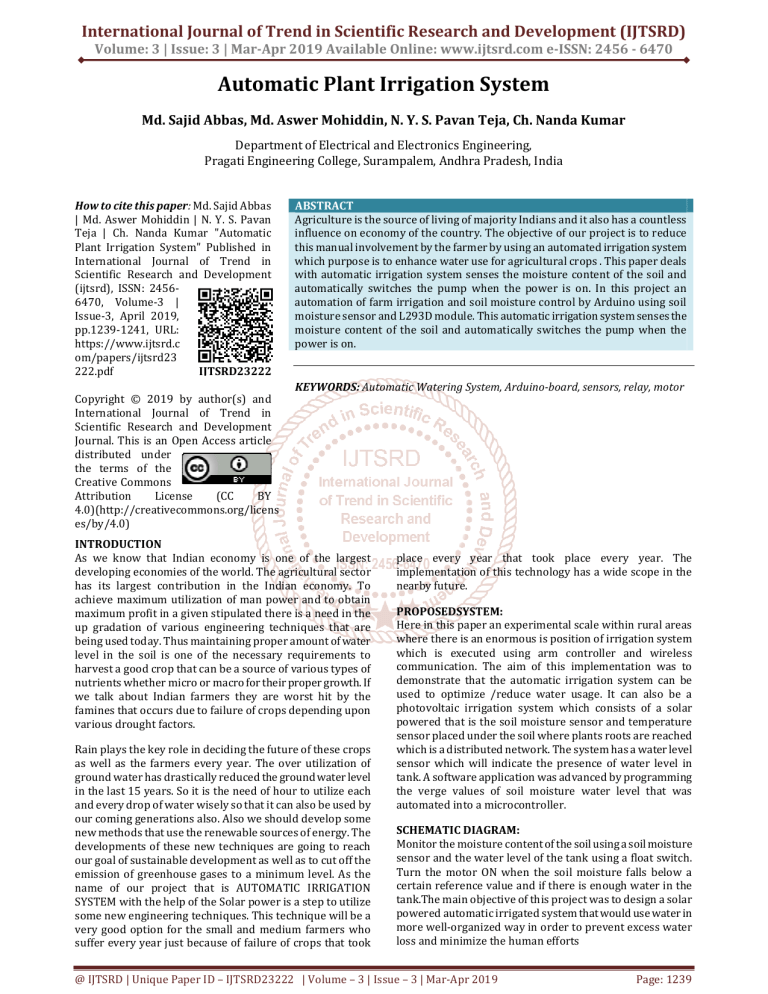
International Journal of Trend in Scientific Research and Development (IJTSRD) Volume: 3 | Issue: 3 | Mar-Apr 2019 Available Online: www.ijtsrd.com e-ISSN: 2456 - 6470 Automatic Plant Irrigation System Md. Sajid Abbas, Md. Aswer Mohiddin, N. Y. S. Pavan Teja, Ch. Nanda Kumar Department of Electrical and Electronics Engineering, Pragati Engineering College, Surampalem, Andhra Pradesh, India How to cite this paper: Md. Sajid Abbas | Md. Aswer Mohiddin | N. Y. S. Pavan Teja | Ch. Nanda Kumar "Automatic Plant Irrigation System" Published in International Journal of Trend in Scientific Research and Development (ijtsrd), ISSN: 24566470, Volume-3 | Issue-3, April 2019, pp.1239-1241, URL: https://www.ijtsrd.c om/papers/ijtsrd23 IJTSRD23222 222.pdf ABSTRACT Agriculture is the source of living of majority Indians and it also has a countless influence on economy of the country. The objective of our project is to reduce this manual involvement by the farmer by using an automated irrigation system which purpose is to enhance water use for agricultural crops . This paper deals with automatic irrigation system senses the moisture content of the soil and automatically switches the pump when the power is on. In this project an automation of farm irrigation and soil moisture control by Arduino using soil moisture sensor and L293D module. This automatic irrigation system senses the moisture content of the soil and automatically switches the pump when the power is on. KEYWORDS: Automatic Watering System, Arduino-board, sensors, relay, motor Copyright © 2019 by author(s) and International Journal of Trend in Scientific Research and Development Journal. This is an Open Access article distributed under the terms of the Creative Commons Attribution License (CC BY 4.0)(http://creativecommons.org/licens es/by/4.0) INTRODUCTION As we know that Indian economy is one of the largest developing economies of the world. The agricultural sector has its largest contribution in the Indian economy. To achieve maximum utilization of man power and to obtain maximum profit in a given stipulated there is a need in the up gradation of various engineering techniques that are being used today. Thus maintaining proper amount of water level in the soil is one of the necessary requirements to harvest a good crop that can be a source of various types of nutrients whether micro or macro for their proper growth. If we talk about Indian farmers they are worst hit by the famines that occurs due to failure of crops depending upon various drought factors. Rain plays the key role in deciding the future of these crops as well as the farmers every year. The over utilization of ground water has drastically reduced the ground water level in the last 15 years. So it is the need of hour to utilize each and every drop of water wisely so that it can also be used by our coming generations also. Also we should develop some new methods that use the renewable sources of energy. The developments of these new techniques are going to reach our goal of sustainable development as well as to cut off the emission of greenhouse gases to a minimum level. As the name of our project that is AUTOMATIC IRRIGATION SYSTEM with the help of the Solar power is a step to utilize some new engineering techniques. This technique will be a very good option for the small and medium farmers who suffer every year just because of failure of crops that took place every year that took place every year. The implementation of this technology has a wide scope in the nearby future. PROPOSEDSYSTEM: Here in this paper an experimental scale within rural areas where there is an enormous is position of irrigation system which is executed using arm controller and wireless communication. The aim of this implementation was to demonstrate that the automatic irrigation system can be used to optimize /reduce water usage. It can also be a photovoltaic irrigation system which consists of a solar powered that is the soil moisture sensor and temperature sensor placed under the soil where plants roots are reached which is a distributed network. The system has a water level sensor which will indicate the presence of water level in tank. A software application was advanced by programming the verge values of soil moisture water level that was automated into a microcontroller. SCHEMATIC DIAGRAM: Monitor the moisture content of the soil using a soil moisture sensor and the water level of the tank using a float switch. Turn the motor ON when the soil moisture falls below a certain reference value and if there is enough water in the tank.The main objective of this project was to design a solar powered automatic irrigated system that would use water in more well-organized way in order to prevent excess water loss and minimize the human efforts @ IJTSRD | Unique Paper ID – IJTSRD23222 | Volume – 3 | Issue – 3 | Mar-Apr 2019 Page: 1239 International Journal of Trend in Scientific Research and Development (IJTSRD) @ www.ijtsrd.com eISSN: 2456-6470 Relay:Relay is an electrically operated switch. Several relays use a magnet to automatically operate a switch, however alternative in operation principles are used, like solid state relays. Relays are used wherever it's necessary to regulate a circuit by a separate low-power signal, or wherever many circuits should be controlled by one signal. The essential relays were handling in long distance communicate circuits as amplifiers, they unbroken the signal coming back in from one circuit and retransmitted it on another circuit.. CIRCUIT DIAGRAM AND WORKING The soil moisture sensor modules used here have two output pins (Digital output and Analog output). The output from the probe of the moisture sensor is compared with a reference value using an lm393 comparator. The reference value can be changed by turning the potentiometer in the module. The digital pin gives an active low output when the soil is wet. Here we are using the analog output from the module by connecting it to one of the analog pins of Arduino While using the analog output the wet detection value can be set/adjusted within the program itself. As shown in the circuit diagram, a float switch is connected to one of the analog pins of Arduino and a 1K Ohm resistor is used to pull up the line. Analog pins of Arduino can also be used as digital inputs. The status of the tank is identified by checking the output of the float switch. Arduino reads the voltagedropped across the pull up resistor for sensing the level of water in the tank. . And the pin links to the base of a 555IC transistor which in turn drives the 9 V DC motor. HARDWARE REQUIREMENTS The circuit diagram of Automatic plant watering system is shown in figure 1 and is built aroundone of the most popular IC, IC555. It also includes pump and other passive components 555 IC:The 555 timer IC is an integrated circuit chip used in a variety of timer, pulse generation,and oscillator applications. The 555 can be used to provide time delays, as an oscillator, and as a flip-flop element. Derivatives provide two (556) or four (558) timing circuits in one package Fig 3: LED Soil Sensor:Soil moisture sensors measure the humidity of water content in soil. Since the direct hydrometric measuring of free soil wetness needs removing, drying, and coefficient of a sample, soil wetness sensors). live the meter water content indirectly by victimization another property of the soil, like electrical phenomenon, non-conductor constant, or interaction with neutrons, as a proxy for the wetness content. Light-emitting diode (LED):LED is a semiconductor light source that emits light when current flows through it. When a current flows through the diode, electrons are able to recombine with electron holes within the device, releasing energy in the form of photons. This effect is called electroluminescence. The color of the light (corresponding to the energy of the photons) is determined by the energy band gap of the semiconductor. White light is obtained by using multiple semiconductors or a layer of light-emitting phosphor on the semiconductor device. 555 timer @ IJTSRD | Unique Paper ID – IJTSRD23222 | Volume – 3 | Issue – 3 | Mar-Apr 2019 Page: 1240 International Journal of Trend in Scientific Research and Development (IJTSRD) @ www.ijtsrd.com eISSN: 2456-6470 Voltage Regulator:A voltage regulator IC maintains the output voltage at a constant value. 7805 IC, a member of 78xx series of fixed linear voltage regulators used to maintain such fluctuations, is a popular voltage regulator integrated circuit (IC). The xx in 78xx indicates the output voltage it provides.A voltage regulator generates a fixed output voltage of a reset magnitude that remains constant regardless of hanges to its input voltage or load conditions. There are two types of voltage regulators linear and switching. been developed by integrated features of all the hardware components used. Presence of every module has been reasoned out and placed carefully, thus contributing to the best working of the unit The moisture sensors measure the moisture level (water content) of the different plants. If the moisture level is goes to be below the desired and limited level, the moisture sensor sends the signal to the Arduino board which triggers the Water Pump to turn ON and supply the water to respective plant using the Rotating Platform/Sprinkler. When the desired moisture level is reached, the system halts on its own and the water Pump is turned OFF.Thus, the functionality of the entire system has been tested thoroughly and it is said to function successfully. Reference [1] Y. Kim and R. G. Evans, ―Software design for wirelesssensor-basedsite-specific irrigation,ǁComput. Electron. Agricult., vol. 66, no.2,pp. 159–165, May 2009. [2] D. K. Fisher and H. A. Kebede, ―A low-cost microcontroller-basedsystem to monitor crop temperature and water status,ǁComput. Electron. Agricult., vol. 74, no. 1, pp. 168–173, Oct. 2010. RESULTS: The system was tested in the field conditions and results revealed that, system would be a best option for medium size agriculture field. Operational amplifier reference voltage could be changed according to the crop type and moisture availability in the field by using moisture sensor. Excess power was stored in the solar battery and it was used when day light was low. Excess charging was prohibited by using pulse width modulation technique and it helped to reduce the temperature of the solar battery and increase the life time of the battery. When all probes were dry, water pump was switched on until all the probes were getting wet. As well as when all probes were wet, it allocated to dry till two probes and utilize the water and power sustainable manner. If further reduction of the moisture of the soil occurred, it leaded to switch on the pump till all probes getting wet. Because of this automated system water wastage of the tested field could be reduced by 50% of normal irrigation wastage and reduce evapo transpiration by induced dark time operation. Beside human attention was reduced on irrigation due to automation. Irrigation becomes easy, accurate and practical with the impression above shared and can be executed in agricultural fields in future to endorse agriculture to next level. The output from moisture sensor and level system plays wide role in producing the output. [3] K.Srikar ,M.Akhil ,V.Krishna reddy,” Execution of Cloud Scheduling Algorithms”,International Innovative Research Journal of Engineering and Technology, vol 02, no 04,pp.108-111,2017. [4] Y. Kim, J. D. Jabro, and R. G. Evans, ―Wireless lysimeters for realtime online soil water monitoring,ǁ Irrigation Sci., vol. 29, no. 5,pp. 423–430, Sep. 2011 [5] O. Mirabella and M. Brischetto, A hybrid wired wireless networking infrastructure for greenhouse management,ǁ IEEE Trans. Instrum. Meas.,vol. 60, no. 2, pp. 398–407, Feb. 2011. [18] I. F. Akyildiz, W. Su, Y. Sankarasubramaniam, and E. Cayirci, ―A surveyon sensor networks, ǁIEEE Commun. Mag., vol. 40, no. 8, pp. 104–112,Aug. 2002. [6] J. Yick, B. Mukherjee, and D. Ghosal, ―Wireless sensor network survey,ǁComput. Netw., vol. 52, no. 12, pp. 2292–2330, Aug. 2008. [7] M. Winkler, K.-D. Tuchs, K. Hughes, and G. Barclay, ―Theoretical andpractical aspects of military wireless sensor networks,ǁJ. Telecommun.Inf. Technol., vol. 2, pp. 37–45, Apr./Jun. 2008. [8] M. P. Durisic, Z. Tafa, G. Dimic, and V. Milutinovic, ―A survey ofmilitary applications of wireless sensor networks,ǁ inProc. MECO,Jun. 2012, pp. 196–199. [9] M. C. Rodríguez-Sánchez, S. Borromeo, and J. A. Hernández-Tamames, ―Wireless sensor networks for conservation and monitoring cultural assets, ǁIEEE Sensors J., vol. 11, no. 6, pp. 1382–1389, Jun. 2011. [10] G. López, V. Custodio, and J. I. Moreno, ―LOBIN: Etextile and wireless sensor network based platform for healthcare monitoring in future hospital environments,ǁ IEEE Trans. Inf. Technol. Biomed., vol. 14, no. 6, pp. 1446–1458, Nov. 2010. [11] J. M. Corchado, J. Bajo, D. I. Tapia, and A. Abraham, monitoring system for healthcare,ǁ IEEE Trans. Inf. Technol. Biomed., vol. 14, no. 2,pp. 234–240,Mar,2013 CONCLUSION Thus the “Automated Irrigation system based on soil moisture” has been designed and tested successfully. It has @ IJTSRD | Unique Paper ID – IJTSRD23222 | Volume – 3 | Issue – 3 | Mar-Apr 2019 Page: 1241
